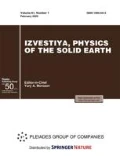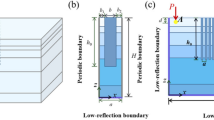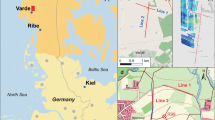Abstract
Field investigations of the amplitude dependence of the P wave velocity in dry and water-saturated rocks are carried out in the space between two shallow boreholes. The seismic wave velocity nonlinearly varies with the strain amplitude in the range ∼(4–50) × 10−8. The pattern of the velocity variation with amplitude depends on the pulse propagation direction. In dry and partially water-saturated rocks, the wave velocity decreases by 1.5% with the amplitude increasing within the range mentioned above and increases by 0.4% in completely water-saturated rocks (with an accuracy of up to 0.1%). Amplitude variations within a closed cycle (A min … → A max … → A min) lead to hysteresis in the V p (A min-max-min) dependence (i.e., the ascending and descending branches of the curve do not coincide). If the hysteretic loop is not closed, the residual velocity component ΔV p (A) is present. This effect is observed in dry and weakly saturated rocks. In a completely saturated rock, hysteresis of the velocity dependence is absent; the ascending and descending amplitude branches coincide. It is suggested that the amplitude characteristics and their hysteresis can be used in the future as an additional criterion for the differentiation of rocks by their fluid saturation.
Similar content being viewed by others
References
A. S. Aleshin and I. Ya. Koval’skaya, “Vibratory Source in Problems of Seismic Microregionalization,” in Problems of Engineering Seismology, Vol. 30: Assessment of the Strong Earthquake Effect (Moscow, 1989), pp. 90–94 [in Russian].
J. Dvorkin, J. Walls, T. Taner, et al., “Attenuation at Patchy Saturation” in A Model EAGE 65 Conference and Exhibition, Stavanger, Norway, 2–5 June, 2003.
G. V. Egorov, V. M. Nosov, and V. V. Man’kovskii, “Experimental Estimation of Nonlinear Elastic Parameters in Dry and Fluid-Saturated Porous Media,” Geol. Geofiz. 40(3), 457–464 (1999).
R. B. Gordon and L. A. Davis, “Velocity and Attenuation of Seismic Waves in Imperfectly Elastic Rock,” J. Geophys. Res. 73(12), 3917–3935 (1968).
V. E. Gusev, W. Lauriks, and J. Thoen, “Dispersion of Nonlinearity, Nonlinear Dispersion, and Absorption of Sound in Micro-Inhomogeneous Materials,” J. Acoust. Soc. Am. 103(6), 3216–3226 (1998).
R. A. Guyer, K. R. McCall, and G. N. Boitnott, “Hysteresis, Discrete Memory and Nonlinear Wave Propagation in Rock: A New Paradigm,” Phys Rev. Lett. 74(17), 3491–3494 (1995).
B. O. Hardin and V. P. Drnevich, “Shear Modulus and Damping in Soils: Design Equations and Curves,” Proc. Am. Soc. Civil. Eng., J. Soil. Mech. Found. Div. 98, 667–692 (1972).
P. A. Johnson, B. Zinszner, and P. N. J. Rasolofosoan, “Resonance and Elastic Nonlinear Phenomena in Rock,” J. Geophys. Res. 101(B5), 11 533–11 554 (1996).
D. H. Johnston and M. N. Toksöz, “Thermal Cracking and Amplitude Dependent Attenuation,” J. Geophys. Res. 85 937–942 (1980).
E. I. Mashinskii, “Quasi-Microplastic Processes and Nonlinear Seismics,” Fiz. Zemli, No. 2, 3–10 (1994).
E. I. Mashinskii, “Nonlinearity of the Quasi-Static Stress-Strain Relation: Dependence on the Mechanical Energy Level,” Geofizika, No. 2, 37–41 (2001).
E. I. Mashinskii, “Geophysical Implications of the Natural Gamma Ray Background,” Fiz. Zemli, No. 11, 1–7 (2003) [Izvestiya, Phys. Solid Earth 39, 992–998 (2003)].
E. I. Mashinskii, “Variants of the Strain Amplitude Dependence of Elastic Wave Velocities in Rocks under Pressure,” J. Geophys. Eng. 1(4) 295–306 (2004a).
E. I. Mashinskii, “Deviations in Stress-Strain Curves and the Amplitude Dependence of Wave Velocities,” Ross. Geofiz. Zh., No. 33–34, 4–11 (2004b).
E. I. Mashinskii, “Non-Linear Stress-Strain Relation in Sedimentary Rocks and Its Effect on Seismic Wave Velocity,” Geophysica 41(1), 3–17 (2005a).
E. I. Mashinskii, “Experimental Study of the Amplitude Effect on Wave Velocity and Attenuation in Consolidated Rocks under Confining Pressure,” J. Geophys. Eng. 2(3), 199–212 (2005b).
E. I. Mashinskii, “Nonlinear Amplitude-Frequency Characteristics of Attenuation in Rock under Pressure,” J. Geophys. Eng., No. 3, 291–306 (2006).
E. I. Mashinskii and G. N. D’yakov, “Amplitude-Dependent Attenuation of Pulse Signals in Rocks,” Fiz. Zemli, No. 11, 63–67 (1999) [Izvestiya, Phys. Solid Earth 35, 937–940 (1999)].
E. I. Mashinskii, V. Z. Koksharov, and Yu. A. Nefedkin, “Amplitude Dependent Effects in a Small Seismic Strain Range,” Geol. Geofiz. 40(4), 611–618 (1999).
G. M. Mavko, “Friction Attenuation: An Inherent Amplitude Dependence,” J. Geophys. Res. 84(B9), 4769–4775 (1979).
G. Mavko and J. Dvorkin, “P-Wave Attenuation in Reservoir and Non-Reservoir Rock,” in EAGE 67 Conference and Exhibition, Madrid, Spain, 13–16 June, 2005.
K. R. McCall and R. A. Guyer, “Equation of State and Wave Propagation in Hysteretic Nonlinear Elastic Materials,” J. Geophys. Res. 99(B12), 23887–23897 (1994).
L. A. Ostrovsky and P.A. Johnson, “Dynamic Nonlinear Elasticity in Geomaterials,” La Rivista del Nuovo Cimento 24(7), Ser. 4 (2001).
O. V. Pavlenko, “Elastic Nonlinearity of Sedimentary Rocks,” Dokl. Akad. Nauk 389(2), 247–251 (2003).
O. V. Pavlenko, “Changes in Shear Moduli of Shallow Grounds in the Epicentral Zone of the Kobe 1995 Earthquake (Japan) during the Main Shock and Aftershocks,” Dokl. Ross. Akad. Nauk 398(5), 680–685 (2004a).
O. V. Pavlenko, “Identification of Nonlinearly Elastic Behavior of Ground in Near-Fault Zones of the Tottori 2002 Earthquake (Japan),” Dokl. Ross. Akad. Nauk 398(6), 803–809 (2004b).
O. V. Pavlenko, “Soil Behavior during Strong Earthquakes from Records of Vertical Seismic Arrays,” Fiz. Zemli, No. 2, 30–40 (2005) [Izvestiya, Phys. Solid Earth 41, 121–131 (2005).
O. V. Pavlenko and K. Irikura, “Changes in Shear Moduli of Liquefied and Nonliquefied Soils during the 1995 Kobe Earthquake and Its Aftershocks at PI, SGK, and TKS Vertical Array Sites,” Bull. Seismol. Soc. Am. 92(5), 1952–1969 (2002a).
O. V. Pavlenko and K. Irikura, “Nonlinearity in the Response of Soils in the 1995 Kobe Earthquake in Vertical Components of Records,” Soil Dynamics and Earthquake Engineering 22, 967–975 (2002b).
R. R. Stewart, M. N. Toksöz, and A. Timur, “Strain Dependent: Observation and Proposed Mechanism,” J. Geophys. Res. 88(B1) 546–554 (1983).
A. N. Tutuncu, A. L. Podio, A. R. Gregory, and M. M. Sharma, “Nonlinear Viscoelastic Behavior of Sedimentary Rocks, Part I: Effect of Frequency and Strain Amplitude,” Geophysics 63(1), 184–194 (1998a).
A. N. Tutuncu, A. L. Podio, and M. M. Sharma, “Nonlinear Viscoelastic Behavior of Sedimentary Rocks, Part II: Hysteresis Effect and Influence of Type of Fluid on Elastic Moduli,” Geophysics 63(1), 195–203 (1998b).
Yu. I. Vasil’ev, A. A. Gvozdev, A. I. Ivanova, et al. “Mechanical Properties of Soft Ground at Stresses to (5−10) × 105 Pa, or 5–10 kg/cm2, and the Choice of a Model Describing the Ground Behavior during Strong Earthquakes,” in Seismic Microregionalization (Nauka, Moscow, 1977), pp. 121–129 [in Russian].
K. A. Winkler, A. Nur, and M. Gladwin, “Friction and Seismic Attenuation in Rock,” Nature 274 528–531 (1979).
H. Xu, S. M. Day, and J.-B. H. Minster, “Model for Nonlinear Wave Propagation Derived from Rock Hysteresis Measurements,” J. Geophys. Res. 103(B12), 29 915–29 929 (1998).
Xu Li and Vernon F. Cormier, “Frequency-Dependent Seismic Attenuation in Inner Core 1. A Viscoelastic Interpretation,” J. Geophys. Res. 107(B12), 2361–2370 (2002).
V. Yu. Zaitsev, V. E. Nazarov, and V. I. Talanov, “Experimental Study of the Self-Action of Seismoacoustic Waves,” Acoust. Phys. 45(6), 720–726 (1999).
Author information
Authors and Affiliations
Corresponding author
Additional information
Original Russian Text © E.I. Mashinskii, 2007, published in Fizika Zemli, 2007, No. 8, pp. 65–73.
Rights and permissions
About this article
Cite this article
Mashinskii, E.I. Amplitude-dependent effects of longitudinal seismic wave propagation in the interhole space. Izv., Phys. Solid Earth 43, 683–690 (2007). https://doi.org/10.1134/S1069351307080083
Received:
Accepted:
Issue Date:
DOI: https://doi.org/10.1134/S1069351307080083




